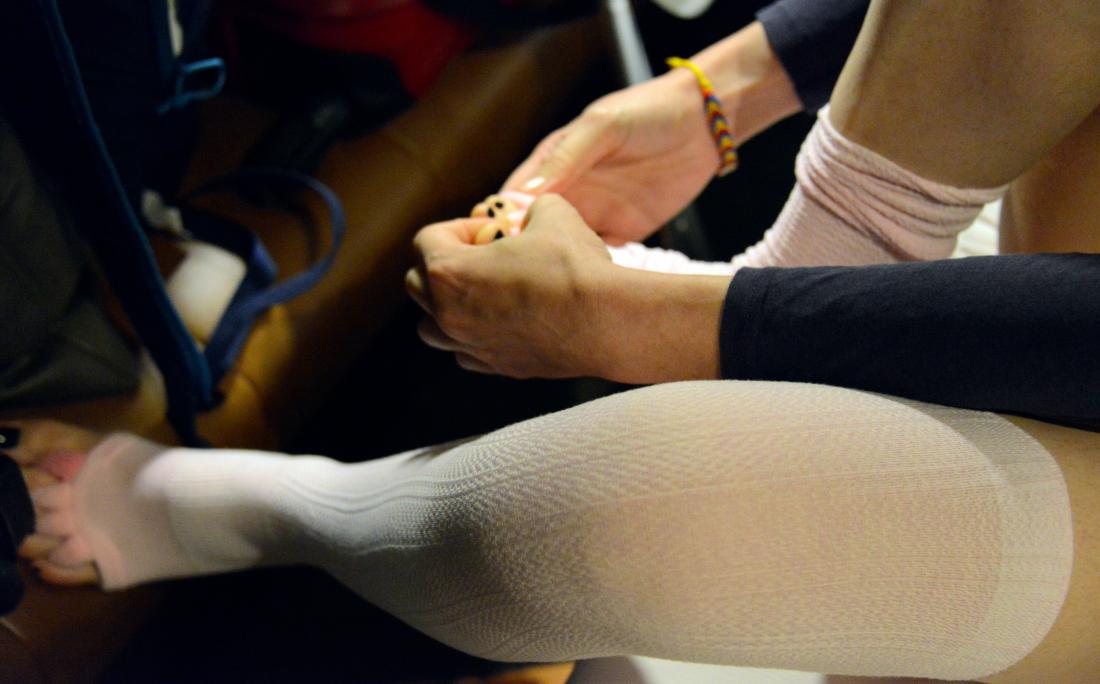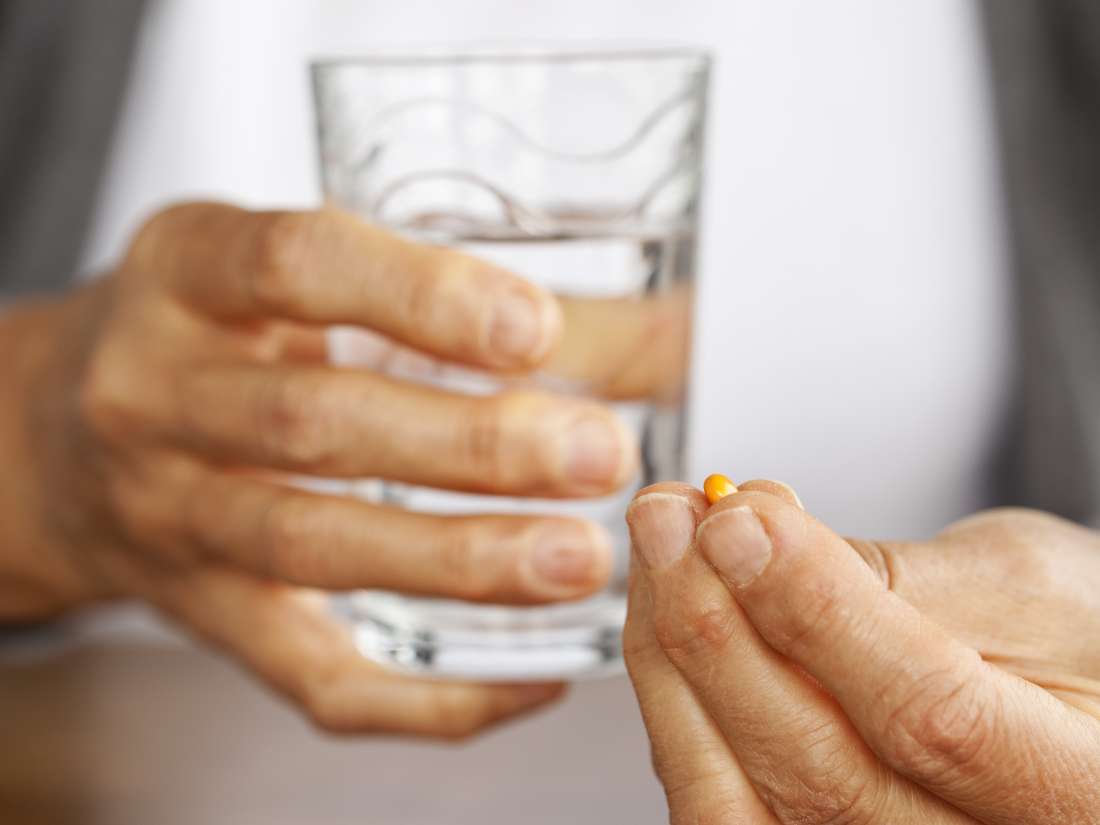Some clots may also fail to dissolve fully once an injury has healed. These clots can travel through the circulatory system and may end up restricting blood supply to a vital organ. These types of blood clot are very serious and require urgent treatment.
In this article, we outline the various treatments for blood clots and provide tips on the prevention and long-term management of blood clotting disorders.
Treatment
The treatment options for blood clots depend on a person’s overall health and the location of the blood clot.
Anticoagulant medications

A doctor may prescribe anticoagulant medications to treat blood clots.
In most cases, a doctor will prescribe anticoagulant medications, which people often refer to as blood thinners. These medications reduce the body’s ability to form new clots, while also preventing existing clots from getting bigger.
Doctors usually deliver anticoagulant medications during the first 5–10 days after the diagnosis of a blood clot.
Some people may continue taking anticoagulants for weeks, months, or even years to keep clots from returning.
The most common anticoagulant medications include:
Unfractionated heparin
Unfractionated heparin (UFH) works with antithrombin — a protein in the body — to prevent new clots from forming.
A doctor will administer UFH intravenously or via an injection just beneath the skin to allow the drug to work quickly.
Blood levels of UFH may change intermittently throughout the day. For this reason, a person receiving UFH will require several blood tests daily.
Low molecular weight heparin
Low molecular weight heparin (LMWH) comes from UFH. The effects of LMWH on the body last longer than those of UFH and are more predictable.
People taking LMWH can self-inject it at home, and they do not require routine blood monitoring.
Warfarin
Warfarin works by interfering with the production of vitamin K. The liver uses vitamin K to make proteins necessary for blood clotting.
A doctor may prescribe warfarin pills for people who are transitioning from heparin treatment.
Throughout the first week of treatment, a person will require several blood tests so that doctors can determine the correct dosage. Once a person has an established dosage, routine blood monitoring will be necessary to prevent the risk of uncontrolled bleeding.
Direct oral anticoagulant medications
Direct oral anticoagulants (DOACs) are a newer class of anticoagulants. These drugs directly target the specific proteins responsible for blood clotting.
DOACs act rapidly, and their effects on the body are short lasting. Missing a dose can increase the risk of blood clots.
When a person takes them correctly, DOACs carry fewer risks than warfarin. They are less likely to cause bleeding and to interact with foods, supplements, and other medications.
However, they tend to be more expensive. It is also vital that people do not miss their regular doses.
Some DOAC drugs include:
- apixaban (Eliquis)
- betrixaban (BevyxXa)
- dabigatran (Pradaxa)
- edoxaban (Savaysa)
- rivaroxaban (Xarelto)
Compression stockings
People who develop a blood clot in one of the deep veins in the arms and legs, called deep vein thrombosis (DVT), may go on to experience postthrombotic syndrome (PTS). In people with PTS, the damaged blood vessels become swollen and painful.
Compression stockings are elasticated stockings that fit over the foot and extend up to the calf or groin. These stockings are tight at the foot but get looser further up the leg.
This design assists blood flow out of the lower legs and back up toward the heart, helping relieve the symptoms of PTS.
Compressions stockings are available either on prescription or over the counter at most major drugstores. A pharmacist will need to measure the leg to ensure that the stockings fit correctly.
Thrombolytics
Thrombolytics are drugs that dissolve blood clots. A doctor may give a thrombolytic intravenously, or they may use a catheter in the vein, which will allow them to deliver the drug directly to the site of the clot.
Thrombolytics can increase the risk of bleeding, however. Doctors usually only recommend them for people who have very large clots or clots that do not resolve with anticoagulant treatment.
These drugs may also be an option for people who have persistent and debilitating PTS.
Surgical thrombectomy
In some cases, surgery may be necessary to remove a blood clot from a vein or artery. This procedure is called a thrombectomy.
A thrombectomy may be necessary for clots that are very large or are causing severe damage to nearby tissues.
People should talk to their surgeon about what to expect during the procedure.
In most cases, the surgeon will make a cut in the area above the blood clot. After removing the clot, the surgeon may insert a small tube or “stent” into the blood vessel to keep it open. They will then close off the blood vessel to restore blood flow.
Vena cava filters
The vena cava is a large vein in the abdomen that transports blood from the lower body back up to the heart and lungs.
A DVT in the legs can sometimes travel up to the lungs through the vena cava. When the clot moves to the lungs and blocks blood flow, it is called a pulmonary embolism (PE). A surgeon may insert a filter into the vena cava to prevent clots from passing through the vein.
The surgeon inserts the filter by making a small incision in a vein in the neck or groin. A series of X-rays helps the surgeon correctly position the filter inside the vena cava.
Doctors usually only use this procedure for people who are at high risk of developing a pulmonary embolism and those who cannot take anticoagulants.
Home management

A person with DVT may benefit from wearing compression stockings.
A doctor will set out a tailored treatment plan to help people manage their condition and prevent further blood clots.
Home management will depend on the type and severity of the blood clot, as well as which medications a person is taking for it.
The plan may involve the doctor referring a person to a team of specialists, who are likely to include a cardiologist, hematologist, and neurologist.
Compression stockings may be beneficial for people recovering from DVT. These stockings help prevent blood from pooling and clotting in the lower leg.
Taking regular walks and elevating the affected leg above the hip can also help by increasing blood flow to the heart.
People who are taking medications should schedule regular blood checks to ensure that their blood does not become too thin or thick.
Prevention
According to the American Society of Hematology, blood clots are one of the most preventable types of blood condition.
Some individuals may have an increased genetic risk of developing blood clots. People should tell their doctor if they have a family history of blood clotting disorders.
The doctor may recommend regular checkups to help detect disorders at an early stage.
The following lifestyle factors can also lower a person’s risk of developing blood clots:
- wearing loose fitting clothes, especially on the lower body
- wearing compression stockings
- quitting smoking, if applicable
- drinking plenty of fluids
- eating less salt
- exercising regularly
- maintaining a healthy weight
- changing position often, especially on long journeys
- standing or sitting for no longer than an hour at a time
- avoiding crossing the legs
- avoiding activities that may bump and knock the legs
- raising the legs above the level of the heart when lying down
Signs and symptoms
The table below shows the symptoms that may occur with blood clots in different parts of the body:
| Location | Symptoms |
| Arm or leg |
|
| Lung |
|
| Brain |
|
| Heart |
|
| Abdomen | |
| Kidney | Symptoms are rare, but may include:
|
Complications
A DVT is a blood clot that forms within the deep veins in the arms and legs.
Sometimes, a DVT may dislodge and travel through the circulatory system toward the lungs or brain. It can then cause serious complications, including:
Pulmonary embolism
A PE is a blood clot that becomes embedded in the lung tissue.
A PE blocks some of the blood flow to the lung, which causes the heart to pump harder to try to fulfill the body’s oxygen requirements.
The added strain on the circulatory system can result in heart failure.
Cerebral embolism and stroke
Sometimes, a blood clot may enter and block a vessel that supplies blood to the brain. This type of blood clot is called a cerebral embolism (CE).
Without sufficient blood supply, the brain cells in the affected area become starved of oxygen and die. This condition is called an ischemic stroke.
Strokes are serious and potentially life threatening. People who receive treatment within the first 3 hours of having a stroke are less likely to experience lasting disability.
Renal vein thrombosis
A renal vein thrombosis (RVT) is a blood clot in the renal vein, which draws blood away from the kidney. Most cases of RVT improve over time and do not cause lasting kidney damage.
However, RVT may sometimes result in acute renal failure. Acute renal failure is when impaired kidney function leads to a buildup of toxic waste products in the blood.
When to see a doctor

A doctor will recommend early treatment of DVT to prevent further complications.
People who experience the symptoms of a DVT should make an urgent appointment with a doctor, especially if they have a family history of blood clotting disorders. Early treatment of a DVT can prevent further complications.
A blood clot elsewhere in the body is a medical emergency. A person should phone 911 or the local emergency number immediately if they are experiencing symptoms of a stroke, pulmonary embolism, renal vein thrombosis, or another heart-related condition.
Outlook
Blood clots are serious and potentially life threatening in some cases. There are many different treatment options for blood clots, depending on their location and severity.
Early diagnosis and treatment can help prevent further complications and improve a person’s outlook.
